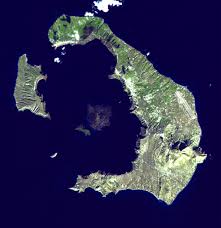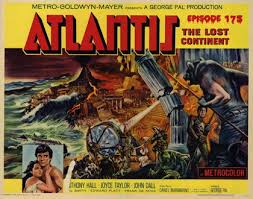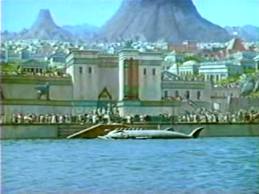 The mystery of Atlantis begins with Plato’s dialogues Timaeus and Critias. He asserts that Atlantis was destroyed in a single day after a failed attempt to conquer Athens. His tale sparked a two thousand year search for the lost continent. Despite Plato’s militaristic potrayal of the Atlanteans, most references depict an advanced utopian society with a few theories postulating ancient alien visits. Most historians dismiss Atlantis as a myth, albeit one inspired by actual events.
The mystery of Atlantis begins with Plato’s dialogues Timaeus and Critias. He asserts that Atlantis was destroyed in a single day after a failed attempt to conquer Athens. His tale sparked a two thousand year search for the lost continent. Despite Plato’s militaristic potrayal of the Atlanteans, most references depict an advanced utopian society with a few theories postulating ancient alien visits. Most historians dismiss Atlantis as a myth, albeit one inspired by actual events.
The most well accepted of these is the eruption of the Thera volcano in the southern Aegean. Sometime around 1600 BC the Thera volcano exploded sending 14 cubic miles of debris into the atmosphere. Scientists estimate an explosive force of 600 megatons or roughly 40,000 Hiroshima bombs. While the heaviest ashfall, more than twenty feet, occurred to the east toward Asia Minor, the loss of so much mass from the mountain led to the collapse of the caldera. Its crash into the sea created a tsunami one hundred feet high, which devastated the dominant Minoan civilization on nearby Crete and inspired the tale of Atlantis. Looking at the satellite view of modern Thera, it’s easy to understand the inspiration. 
However, dozens of other theories exist. One of the more popular is the connection of the Mayan and Aztec civilizations to Atlantis or at least the Atlantean survivors. Others place Atlantis in the Bahamas, Cuba, or somewhere in the Bermuda Triangle. More remote speculation includes parts of South America, Ireland, and even Antarctica. Given enough time you could probably connect almost any point in the western hemisphere to someone’s theory of Atlantis. Mysterious and yet familiar, the Atlantis myth remains a mainstay in our popular culture more than twenty-three hundred years after Plato’s death.
A quick search for Atlantis in today’s media yields over two hundred recent uses including comic books, role playing games, TV shows, movies, songs, albums, and books. Those are just the mainstream media occurrences. If you broaden the search to include independents, the number probably soars by several orders of magnitude. Some of the more recognizable connections are the post-Atlantean downfall setting for Howard’s Conan stories. Aquaman calls the sunken city his home. In 1969 Donovan hit the top ten with ‘Atlantis.’ Countless others including Eoin Colfer, C.S. Lewis, Ayn Rand, Jonathan Stroud, and even Tolkien (Aragorn is the descendant of Atlantean-like survivors), mention or draw inspiration from the Atlantis tale in their work.
 My first recollection of Atlantis is the 1961 movie, Atlantis, the Lost Continent. It will never be confused with great cinema. It’s often noted more for its use of stock footage than anything else. For an 8-year old boy watching it at home on a rainy Saturday afternoon, it was the height of entertainment. Ninety minutes packed with volcanoes, ogre-like monsters, crystal heat rays, a submarine that looked like a cross between the Nautilus and a whale, and battling sorcerers. Get Smart fans might recognize Ed Platt, the Chief, as the good sorcerer. Short of spaceships, it had everything a nerdy kid wanted in a movie.
My first recollection of Atlantis is the 1961 movie, Atlantis, the Lost Continent. It will never be confused with great cinema. It’s often noted more for its use of stock footage than anything else. For an 8-year old boy watching it at home on a rainy Saturday afternoon, it was the height of entertainment. Ninety minutes packed with volcanoes, ogre-like monsters, crystal heat rays, a submarine that looked like a cross between the Nautilus and a whale, and battling sorcerers. Get Smart fans might recognize Ed Platt, the Chief, as the good sorcerer. Short of spaceships, it had everything a nerdy kid wanted in a movie.
 Did Plato believe his story to be factual? Was it a combination of past events and myths or just a convenient creation to support his philosophical writings? Barring the invention of time travel, we’ll probably never know, but it’s sure fun to speculate. My Atlanteans live in a steampunk-like world driven by magneto technology and the manipulation of extra-dimensional energy. Their downfall coincides with the desiccation of the Sahara roughly 6,000 years ago and sets off events that culminate in present day upstate New York.
Did Plato believe his story to be factual? Was it a combination of past events and myths or just a convenient creation to support his philosophical writings? Barring the invention of time travel, we’ll probably never know, but it’s sure fun to speculate. My Atlanteans live in a steampunk-like world driven by magneto technology and the manipulation of extra-dimensional energy. Their downfall coincides with the desiccation of the Sahara roughly 6,000 years ago and sets off events that culminate in present day upstate New York.
Please visit my website for more information about the Misaligned series.
Thanks for reading,
Armen
Here’s an excerpt from Misasligned: The Silver Scepter, book 2 of the series:
“A man should never let his ambitions get in the way of the facts,” said Myrdin, a bit more derisively than he intended. “The pictures show the lifecycle of a butterfly. The leaves look like milkweed, so I’d guess they’re Monarch butterflies, or their prehistoric relative.”
“Yeah, we noticed that. That’s why we call it the butterfly scepter.”
“I suspect they’re purely decorative.”
“A curious choice, don’t you think?”
“I don’t know. The metamorphic lifecycle of the butterfly may not be miraculous to us, but I could see how it might inspire people’s belief in a spiritual renewal.”
Tom smiled. “I didn’t know you were a poet.”
“Just because I’m a scientist, doesn’t mean that I can’t appreciate the beauty of things. Now, as for the script, it does bear some similarities to Minoan Linear A, but there are also some significant differences.”
“Well, I’m glad we called you in. It sounds like you’re the right man for the job.”
“Don’t be too hasty. Linear A may be older than Zapotec, but it’s still several thousand years later than this artifact, and it’s never been deciphered. Even cuneiform, the oldest known form of writing, came a thousand years after this was buried, much less when it was made.”
“I guess you’ve got a real challenge on your hands.”
“Was there anything else in the box? Something that might give us a clue about its origins or purpose?”
“Oh, I almost forgot, there were several dried-out leaves and some fine dust in the box.”
“Contamination?”
“No, they dated to roughly the same timeframe that the box and the scepter were buried. The dust appears to be a mix of pulverized vitric shards, shattered phenocrysts and lithic fragments.”
“Sorry? For the non-geologist in the room?”
“Oh right, it’s volcanic ash, and judging from the fracturing of the crystals, it must’ve been a very powerful eruption. We also found similar particles embedded in the outer surface of the box.”
“Again, pardon my ignorance, but is there any evidence of such volcanic activity in North America 6,000 years ago?”
“No, nothing of this magnitude.”
“Any other possibilities?”
“The timing does correlate closely with the desiccation of the Sahara.”
“I thought that most climatologists attribute the 5.9 kiloyear event to changes in Atlantic Ocean current patterns,” said Myrdin.
“Yes, but there’s a minority who’ve always maintained that those changes were volcanic in origin, and they’ve got some ice core samples from Greenland to support their theory, but…” said Tom.
“But what?”
“Well, the only volcanically active areas in the North Atlantic are in the Caribbean and Iceland. The Caribbean is too far west and Iceland is too far north to effect the changes needed to support their theory. Some of the more adventurous of the group have proposed what is jokingly referred to as the Atlantis solution.”
“You’re kidding?”
“No, their basic hypothesis is that there was an eruption, it caused the desertification of North Africa, and the reason we can’t find it is because the eruption was so violent that all traces of the volcano were swallowed by the ocean and destroyed.”
“An intriguing theory,” said Myrdin, stroking his chin. “However, a mysterious wooden box with ancient volcanic ash found in upstate New York isn’t the type of evidence that will stand up to peer review.”
“No, you’re right. It’s probably just a coincidence – a very bizarre coincidence – but nothing more. Even if we could connect them, how did the box get to Byron? And we’d still have to find the volcano or its remains.”
Sensing his friend’s frustration, Myrdin suggested, “Perhaps the leaves will give us a clue.”


1 thought on “What’s the fascination with Atlantis?”